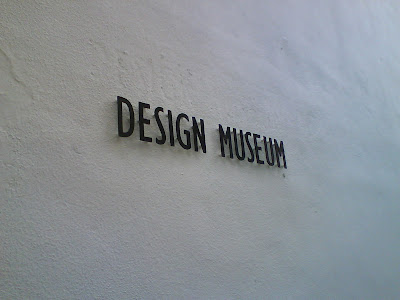
On the second floor of the Design Museum they were exhibiting the best work from the design of the year award. This award covered all forms of design and it was interesting to see what is seen as the best work from each field of design all at one place. All the work at this exhibition were inspiring in various forms.
Here are some photographs of my highlights from the exhibition:
 Barack Obama Poster - USA
Barack Obama Poster - USADesigned by Shepard Fairley
Shepard Fairey is a street artist renowned for his prolific fly posting of propaganda style artwork and Obey the Giant Icon images and to date has attracted a large international following. Fairey was commissioned by the initiative 'Artist for Obama' to create a limited edition art work, to be sold to raise awearness for Obama's 2008 Presedential campaign.
Having seen how much cotrovesy was raised over this election it is inspiring to find how a designer can get involved in such a political campaign in a meanignful way and create such a positive response. This poster symbolised Obama's appeal to a younger audience and the sales of the poster has raised over over four hundered thousand dollars.
 Kinetic Sculpture - Mechatronical Museum Instulation - BMW Museum Germany
Kinetic Sculpture - Mechatronical Museum Instulation - BMW Museum Germany Made by ARTCOM
This sculpture consisted of 714 metal balls suspended from thin steel wires, each individually controlled. Within a grid covering the area of six square metres, they appeared to weightlessly float in the air, rising and falling in an elegant and composed sequence. This sculpture looked amazing. Unfortunately they only had a video and one example of this sculpture in use. I can imagine that if I were to see this in real life (without knowing the technology behind the sculpture) I would have instantly attracted my attention because I would be trying to work out how it works. Pieces of design like this are a great way of attrackting annyones attention and it would be great to witness this sculpture in its full display.
 Cloud - Terminal 5 Heathrow Airport UK
Cloud - Terminal 5 Heathrow Airport UKConcept and design by Trokia
This was an interactive art insulation very similar to the Kinetic sculpture that resembled a strong sens of design and engineering. Using flip-dot material which were more conventionally used in the 1970's and 80's to create signs in airports and train stations. Trokia have reinterpreted it's use to create this insulation piece. The flip-dots can be individually addressed by a computer to animate the entire skin of the sculpture. The dots silver on on side and black on the other, turn 180 degrees at a time and generate a sound reminiscent of travel as well as create a constant change in colour tonnes as the black and grey chase the across the surface.
Unfortunately they only had a small dummy example of this extravagant piece of sculpture at the exhibition. Never the less this version gave a great visual interpretation of how the final product would have been. This was a great example of how technology can develop a traditional piece of engineering and create the unthinkable. This had to be my favorite designs from the exhibition and it would have been great to see Cloud at its final form down at Terminal 5 in Heathrow Airport.

























